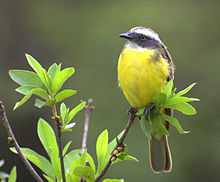Myiozetetes
| Myiozetetes | |
|---|---|
 | |
| Myiozetetes similis | |
| Scientific classification | |
| Kingdom: | Animalia |
| Phylum: | Chordata |
| Class: | Aves |
| Order: | Passeriformes |
| Family: | Tyrannidae |
| Genus: | Myiozetetes P.L. Sclater, 1859 |
| Species | |
|
Myiozetetes cayanensis | |
Myiozetetes is a small genus of passerine birds in the tyrant flycatcher family. The four to five species occur in tropical Central and South America. They are.
- Rusty-margined Flycatcher, Myiozetetes cayanensis
- Social Flycatcher, Myiozetetes similis
- Grey-capped Flycatcher, Myiozetetes granadensis
- Dusky-chested Flycatcher, Myiozetetes luteiventris
The adult Myiozetetes flycatchers are c.16–18 cm long and weighs 24-30 g. The upperparts are olive-brown, and the wings and tail are brown with only faint rufous fringes. The underparts are yellow and the throat is white. Young birds lack the red-orange crown stripe of the adult, and have chestnut fringes to the wing and tail feathers. The best distinction between the species is the head pattern: Vermillion-crowned, Social and Rusty-margined Flycatchers have strong black-and white head markings like the Great Kiskadee, whereas Grey-capped and Dusky-chested Flycatchers have greyish heads, with a short weak eyestripe in the former.
Myiozetetes flycatchers sally out from an open perch in a tree to catch insects in flight. They sometimes hover to take small berries. They breed in cultivation, pasture, and open woodland with some trees, building a large roofed nest from stems and in a bush, tree or on a building. The nest is often constructed near a wasp, bee or ant nest, or the nest of another tyrant flycatcher,. The nest site is often near or over water. The typical clutch is two to four brown or lilac-blotched cream or white eggs, laid between February and June.
References
- Hilty, Steven L. (2003): Birds of Venezuela. Christopher Helm, London. ISBN 0-7136-6418-5
- Stiles, F. Gary & Skutch, Alexander Frank (1989): A guide to the birds of Costa Rica. Comistock, Ithaca. ISBN 0-8014-9600-4